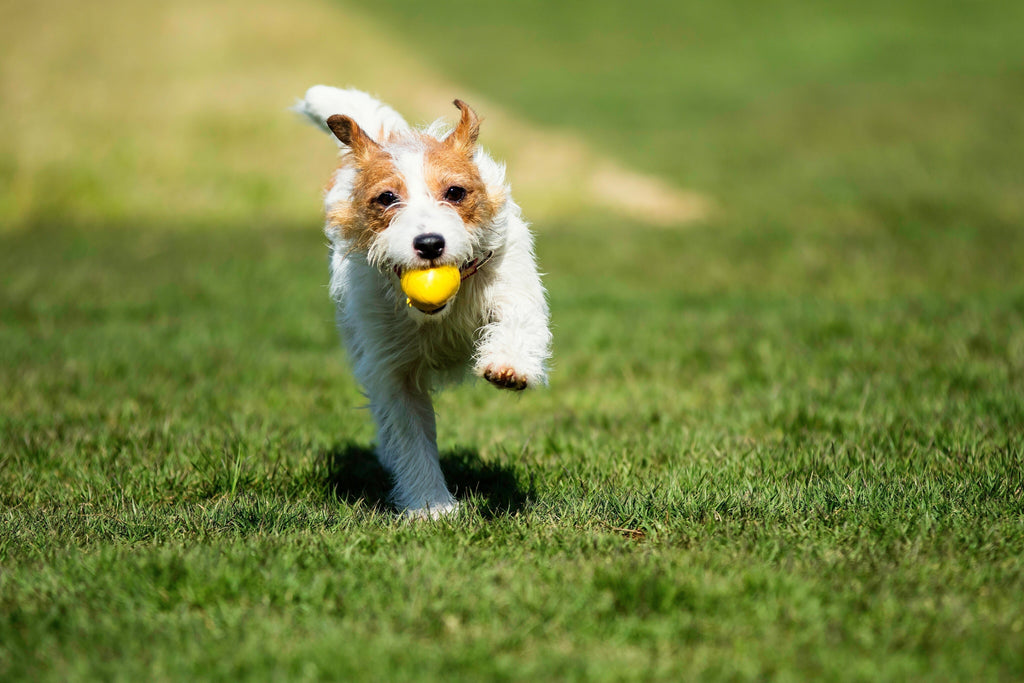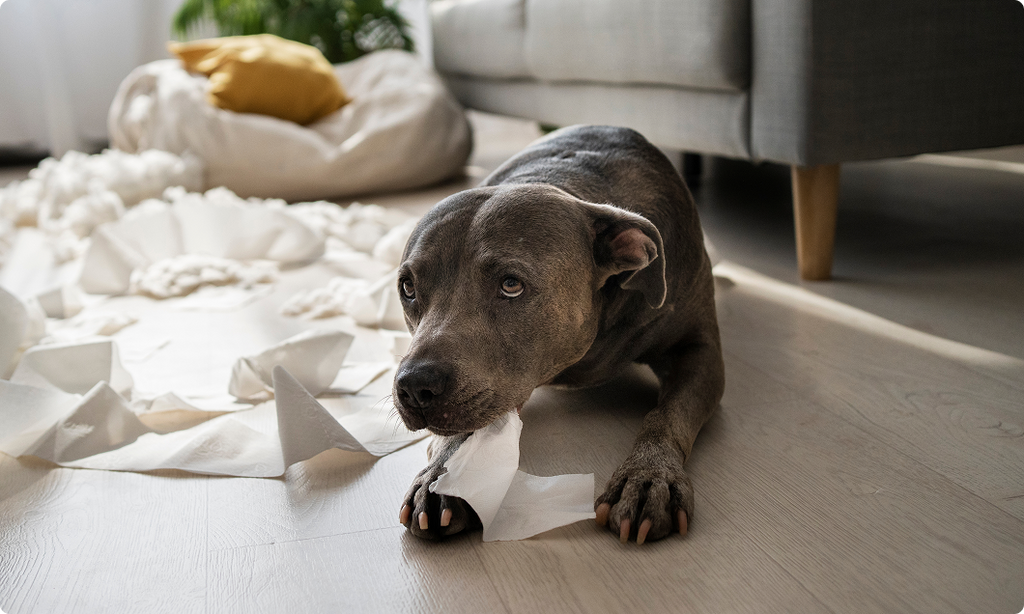10 Human Foods That Are Toxic To Your Dog

Are you one of those dog owners that can’t resist giving your dog a nibble of your dinner? If so, you’re not alone. So many of us dog parents show our love for our dogs through food. However, this isn’t always the best for our dogs’ health.
While the extra calories can really take a toll, many foods we enjoy are unhealthy and can even be toxic for our dogs. Some foods are even so bad for our best friends, that a bite or two can send you rushing to the vet. To keep your canine companion safe, happy, and healthy, always check that what you plan to share is not on this list of human foods that are toxic to your dogs.
1. Xylitol (a Sugar Replacement)

Most dog owners have never heard of xylitol. However, this sugar substitute is actually quite common. In fact, it’s found in most sugar-free gums, gummy vitamins, and even peanut butter (though this is now very rare in Australia). This sweet substance is often marketed as a healthy, all-natural, low-calorie sugar alternative that is better for your dental health. Unfortunately, the effects of this sugar alcohol, are not-too-sweet for dogs.
Even a small amount of xylitol can send your dog into hypoglycemic shock. For small dogs, one piece of gum could result in seizures and even death. While a few pieces of gum for larger dogs can result in permanent liver damage and fatality.
How much Xylitol is toxic to your dog: 0.1g/kg can lead to hypoglycemia (On average a piece of gum has 0.2 -1g!).
What to Watch Out For:
Never let your dog eat sweetened peanut butter or other food without first checking the ingredient list. Sometimes xylitol is listed as “sugar alcohol,” “wood sugar,” “birch bark extract,” or “birch sugar.” Other sweeteners which also can be toxic to dogs include, sorbitol, mannitol, and aspartame!
Common foods that contain Xylitol to avoid feeding your dog:
- Sugar free lollies
- Chewable Vitamins
- Chocolate
- Pancake Syrup
- Protein Bars and Supplements (Aussie Bodies, Bioglan, IsoWhey, Youfoodz)
- Gum (Jila, Mentos, Extra, Wrigleys)
- Toothpaste (Listerene, Oral B, White Glo)
2. Cooked Bones

Although not "poisonous' feeding cooked bones to your dog can be incredibly dangerous! While raw bones are generally beneficial to dogs and often included in dog raw diet foods for their nutritional value, cooked bones can be a choking hazard. They become brittle and can splinter, potentially causing damage to your dog’s mouth or even perforating their digestive tract, which may require life-threatening surgery.
So, cooked bones should always be off-limits to your dog.
3. Grapes, Raisins, Sultanas and Currants

Grapes, along with their dried counterparts like raisins, sultanas, and currants, might be considered a nutritious snack for humans, but they pose a severe toxicity risk to certain dogs. What's particularly alarming about grape toxicity in dogs is that while some may show little to no effect after consuming a few grapes, even a slight increase in quantity can lead to illness. In fact, even a small number of grapes can cause severe illness in certain dogs.
Grape toxicity causes severe diarrhea, lethargy, and acute renal failure.
Why are grapes toxic to dogs?
Two compounds (Tartaric acid and potassium bitartrate) that are found in grapes are very high. Dogs, a long with a few other species (cats, horses and goats) are known to be sensitive to tartaric acid, and some dogs being more sensitive than others!
Are Grapes or Sultanas and Raisins more toxic to your dog?
Although both are considered very toxic, it is thought that the dried versions are considered more likely to cause severe symptoms.
How many grapes is too many? When it comes down to it, any number is too many, as each dog responds differently! The toxic dose is considered 20g per kilogram. That is equivalent to just 3 grapes.
When it comes to grapes, never let your dog eat fresh grapes, raisins, or any baked goods or trail mix with raisins in it.
4. Chocolate

You’ve likely heard that chocolate is poisonous for dogs. Unfortunately, despite the fact that most dog owners know to not give their dogs chocolate, many dogs still get extremely sick and even pass away from chocolate toxicity every year, especially around Easter.
This is often due to dogs breaking into pantries or pulling chocolate down from counters while their owners are away.
Many instances of chocolate poisoning occur around the holiday periods, du to increased access to chocolate due to the bustling activities and celebrations happening in households. With people being busy preparing meals, hosting gatherings, and exchanging gifts, chocolate treats and desserts may be left unattended or easily accessible to curious dogs.
Chocolate also has a strong scent and a delicious taste so who can blame them!
Is Chocolate Really That Dangerous?
What makes chocolate so dangerous? Chocolate contains a substance called “theobromine.” Theobromine is extremely difficult for a dog’s body to metabolise, and the high concentrations cause a dog’s body to go into shock. This reaction often includes tremors, seizures, vomiting, and an elevated heart rate. Too much chocolate can result in heart failure.
"My Dog Only Ate a Little Chocolate. Should I Go to the Vet?"
While most dogs can process a very small amount of milk chocolate, dark chocolate, contains a much higher concentration of theobromine and can quickly affect a dog. So, should your dog get into chocolate, you will first want to assess the situation.
Note:
- How much chocolate did they eat?
First, check the packaging for a clear idea of how much chocolate your dog consumed. Then, estimate how much chocolate is left. Bring the package to the vet with you. - Was the chocolate white chocolate, milk chocolate or dark chocolate?
The darker the chocolate the higher the concentration of Theobromine---and therefore more toxic.
We always suggesting taking your pet to the vet if you do think they may have consumed any form of chocolate so that your vet can asses their vitals and ensure they don't need to take any additional measures. Usually, your dog will start to show signs within 4-12 hours, though not all symptoms are visual.
As a general rule, we suggest going to the vet if your dogs consumes more then:
- Milk chocolate: 99.2 grams per 4.5 kilograms
- Dark chocolate: 42.5 grams per 4.5 kilograms
-
Baking chocolate: 28.4 grams per 9 kilograms
If you think your dog may have eaten chocolate and want to know if it is a toxic level we recommend this great Calculator!
What Are the Symptoms of Chocolate Poisoning?
It can take 4 to 24 hours for a dog to exhibit signs of chocolate toxicity. While the symptoms may be slightly different from one dog to another, these are the most common:
- Restlessness and uneasiness
- Vomiting
- Diarrhea
- Increased heart rate
- Increased urination
- Elevated body temperature
- Low blood pressure
- Tremors and shaking
- Seizures
If you start to see any of the above symptoms, contact your vet immediately.
5. Alcohol

Have you ever wondered if it’s alright for your dog to try a sip or two of beer? The answer is simply “No, it’s not safe.”
Dogs are extremely sensitive to alcohol, and even a few laps of a spilled drink can lead to GI issues, seizures, respiratory problems, liver and kidney damage (and even failure), along with heart and central nervous system effects. For some dogs, alcohol can even be fatal.
6. Macadamia Nuts

Dogs may love peanuts, but macadamia nuts are a no-go for our four-legged friends. Not only are macadamias high in fat, with the potential to cause pancreatitis, Macadamia nuts are highly toxic to dogs even in small amounts.
Although, the reason behind this is still unknown, and dogs are the only species to have signs reported, the toxicity can lead to vomiting, diarrhea, and weakness in the hind legs, paralysis and hypothermia within 12 hours of eating. Luckily though, usually all symptoms resolve on their own, but without proper care of the symptoms could lead to further issues, so it is important to seek proper medical treatment.
How much macadamia is toxic to my dog? As little as 2g per kg bodyweight can cause symptoms - (That's just one nut)!
This means that you should never let your dog snack on any nut mixes that contain macadamia nuts, baked goods that may have macadamia nuts in them, or plain macadamia nuts.
7. Onions, Chives and Garlic

It is important to remember in large volumes, anything can become toxic to pets. Garlic, Onions, Leeks and Chives are part of the Allium family which can be poisonous to both dogs and cats if they eat a single large serving or repeatedly nibble on small amounts over time, due to the compound "Thiosulfate". This can cause an upset tummy, a depressed mood, and dehydration in mild cases. More severe poison levels can result in anemia, shortness of breath, lethargy, and muscle weakness. Certain breeds and species are more sensitive, including cats and Japanese breeds of dogs (e.g Akita, Shiba Inu, Japanese Spitz).
While we don't recommend feeding your pet onion, chives and garlic - small amounts of garlic have actually been shown to have some incredible health benefits and is actually listed as a safe ingredient by AAFCO.
So how much onion is toxic to dogs? 1 full onion (100g) has the potential to be toxic to a 20kg dog!
If you are looking to incorporate garlic into your pets diet, we suggest speaking to your vet or nutritional expert about a safe amount.
8. Avocados

If you can afford to share your avocado on toast with your dog, the occasional slice here and there is fine, and even contains some healthy fats and vitamins, but too much of a good thing is true in this case.
Not only does avocado have the potential to lead to pancreatitis and GI issues, but Avocados also contain a fungicidal toxin known as Persin, which can lead to symptoms like vomiting and diarrhea in dogs. Avocado toxicosis can occur when dogs ingest any part of the avocado plant, including the fruit, stems, leaves, or seeds.
While dogs are more resistant to avocado toxicity compared to some other animals, it's important to err on the side of caution to prevent potential health issues.
Still not convinced? Read vet-backed answer to whether dogs can eat Avocados right here!
9. Cherry, Apricot and Apple Seeds

While the fruit itself is safe for dogs, the seed of both the apricot, cherry and apple contain a compound called amygdalin, which can metabolise into cyanide when ingested by dogs.
Cyanide is a potent toxin that interferes with the body's ability to use oxygen properly, leading to cellular suffocation and potentially causing serious health issues.
Ingesting large amounts of the apricot, cherry or apple seeds can lead to cyanide poisoning in dogs, resulting in symptoms such as difficulty breathing, seizures, gastrointestinal distress, and, in severe cases, death. Even a small number of seeds can potentially pose a risk to dogs, so it's crucial to prevent them from consuming cherry and apple seeds entirely.
10. Coffee

We have all left our morning coffee unattended only to come back to your dog lapping up the warm goodness. Although 1-2 licks is ok for your pet, anything more it can start to become a worry!
Coffee contains a stimulant called caffeine, which is toxic to dogs in large quantities. Caffeine is rapidly absorbed into the bloodstream and affects the central nervous system, heart, and gastrointestinal tract and symptoms may start to show within 1-2 hours of ingestion. The reason why coffee is particularly dangerous for dogs is because they are more sensitive to caffeine than humans, and even small amounts can cause adverse effects.
So how much is too much? The toxic dose of caffeine for dogs is approximately 100 milligrams per 1 kilogram of body weight.
Sometimes Sharing Isn’t Caring When It Comes to Your Dog
When it comes to keeping your dog safe, your best bet is to treat your dog to snacks and goodies formulated just for them. Giving your dog human foods may seem innocent, but the wrong one could make your dog sick or worse. So, stick to dog-safe treats, lock up any potentially poisonous foods out of paw’s reach, and if you must give in to those puppy eyes, always read the ingredients, first.




